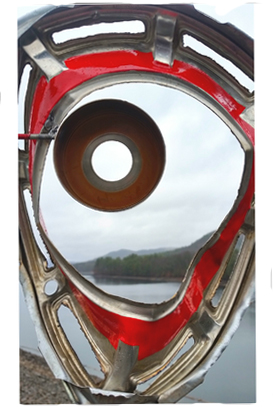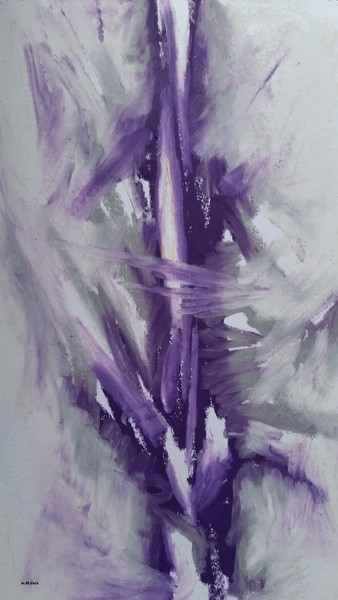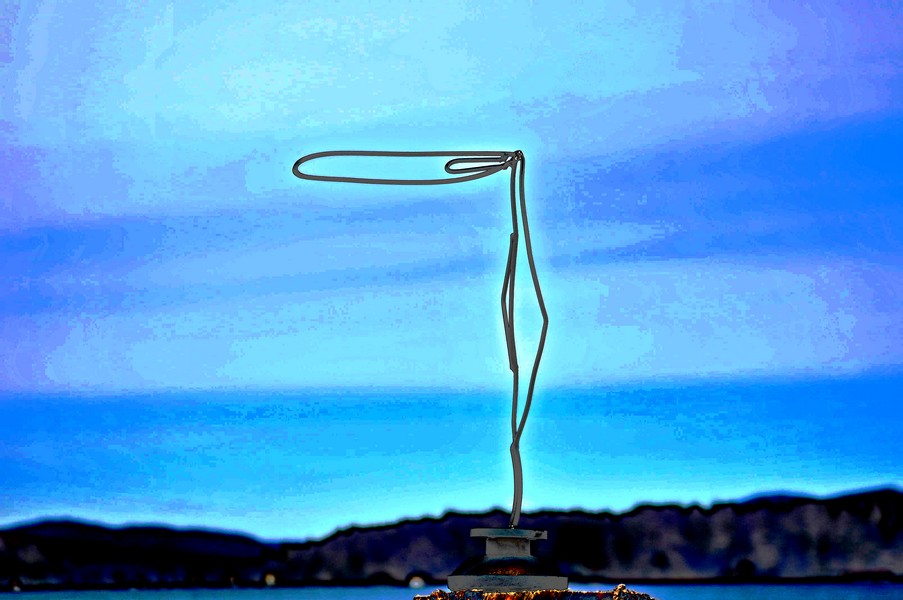One’s Own Separateness of Individuality – A Look through Barnett Newman
By: miChelle Vara – May 2016

In the blackest of clouds a storm with swirling wind and driving rain casts vast depths of the sea. Waves swell as if to hell swooping forward and back reaching over the heavens crashing down the main mast onto the deck of a sailboat, in a non-stop pounding tribal rhythm overwhelming in every way. Your crew is lost. You can’t catch your breath. There is no release to focus. Time has no begging and no end.
You’re in it….
The void….
No way out….
No stop to the ride.
One must see the task to its end.
A do or die situation.
A metaphor of the Subline to this artist.
One walks the question, What is reality to a visual seeker?

Barnet Newman I believe truly understood and put words to subline engagement and the moral obligation of paint as a form of religion. His hermetic being, rooted in Kabbalisum speaks to “Genesis of the creative act for artist as God.” (3) Canvases that work through structure emanating a glow and power being illusionistic, creating relationships between form and space without the tradition of figure grounds. He struggled against subject matter quoting “I raised the issues of modernity and of subject matter. The modern world had rendered traditional art subjects and styles invalid. (5) The highest role a man could achieve – it was a dream”. (4)
Spending his time like a mystic guided in the private presents of the master, being the canvas; distilling contemplative communication, dominating the field of view with color and size. Strategies adapted from his studies to include Freud and Jung he works in direct disconnection to archetypal imagery. The Zips connect the upper and lower of the paintings edge while standing to the foreground or residing in the background. Much like the reaction called into play when viewing the work. This interaction or personal memory is tickled to the conscious foreground or slips into unconscious background while calling the higher or releasing to lower consciousness in the philosophy of the human mind. Capturing the mysterious encounters of forces, grappling with structure of the brain and syntax of word, his play decided by technical choices of color and application, successfully creating dynamic interaction in the viewer. Zips serve to stand as sentinels spurring the energy of wild horses in the glow of an Arizona cadmium red sunset.
Like a god whispering unity, He inspires a syntheses of colliding sensations called magnificent by some mad by others. Clement Greenburg wrote “there is no program, no polemic, in these paintings. They do not intend to make a point, let alone shock or startle,” (7) Barrowing distinction from his friend Meyer Schapiro contrasting “subject Matter” to “Object Matter” in which he believed to be formal considerations of the technical. I wouldn’t have guessed his definition of “Subject matter” to be metaphysical, Non- verbal equivalent to a mathematician’s formula, a composer’s sonnet or poets verse. (6)
He was known to be a happy and enjoyable sort as a child steeling time away from grade school to be in museums, making tar sculptures, a favorite technique throughout his life was drawing with crayons. He was a prolific writer and used that platform to clarify his positions in the visual arena and studied philosophy at the City College of New York and took classes at the Art Students league. (9) He enjoyed repeating short verses like Rabbi Nachman’s famous tale of the simple man who declared that his glass of water was clearer wine and finer beverage than the kings.
The academic viewer always seems to prefix the visual works by importance of Newman’s written statements, solidifying understanding through word. I believe that not to be the case, although his words vast and interesting; the visual works need no words to postulate beauty as an idea, serenity as a response or connection to higher consciousness and vastness in the unknown. Although Melissa Ho in “Talk and the Untalkable” in Reconsidering Barnett Newman: a Symposium at the Philadelphia Museum of Art, 2005; leads me to believe when his paintings exposure and acceptance gathered positive momentum he didn’t have the time to write as much on and around the work. Although I feel much of what he reveals seems allied aggregation to my experience energizing action and removing pensive thought of exploration of thought and visual output.
He called 10 years of his life the “Dark Years” when it seemed his friends nor finances were favorable, even having to sell his wife’s watch to keep all of it going. A time that no one understood or cared about his magic, but it didn’t stop him, he kept pushing like a true prophet. The continual word that comes up in reading about him is metaphysical but I believe a better description would be “solely at one with existentialism.”
He talks about new painting being called plasmic because elements of the art have been converted from surrealism into the mental plasma and the chaos of creation being subject matter in search for what he describes as “truth for the hidden meaning of Life.” Further saying Expressionism was risky because it excluded intellectual, philosophic content in the work. While in rambling in the search for something to paint he explains Modern Art is the pre occupation to solving technical problems in the paint medium. (10) Modern art freed the palette to color but imprisoning the artist in nature to be solved by distortion and leaving the issue to still be what to paint that would break free of trivial and implode the power of the universe. Finding influence in Joyce Ulysses’s automatic writing he said “my idea was that with an automatic move, you could create a world.” Over the next ten years he would work with shapes of life process and seed metaphors.
The piece “Pagan Void” is said to be new life and the egg. (2) I disagree, I feel it’s a wink or nod from the universe staring directly into my soul sheading hope and reassurance one is on the path of enlightened work.

- 1. Barnet Newman, By: Thomas B. Hess, 1971, The Museum of Modern Art,http://www.radford.edu/~rbarris/art428/newman’s%20sublime.html
- 2. Barnet Newman, By: Thomas B. Hess, 1971, The Museum of Modern Art, Pg71
- 3. Barnet Newman, By: Thomas B. Hess, 1971, The Museum of Modern Art, Pg15
- 4. theartstory.org/artist-newman-barnett.htm
- 5. Barnet Newman, By: Thomas B. Hess, 1971, The Museum of Modern Art, Pg16
- 6. Clement Greenberg, “Introduction to exhibition of Barnett Newman,” 1958, The collected Essays and Criticism, vol. 4, ed, John O’Brian (Chicago: University of Chicago Press, 1993), 54.
- 7. The Jewish 100: A Ranking of the Most Influential Jews of All Time, By Michael Shapiro, Daniel Shapiro.
- 8. Perception, Expectations and Meanings in Barnett Newman’s Stations of the Cross Serise, Essay Jeffrey J. Katzin, 2010, Requirement of Wesleyan University Bachelors of Arts.
- 9. Barnet Newman, Essay: “The Problem with Matter”1971, The Museum of Modern Art, Pg39.